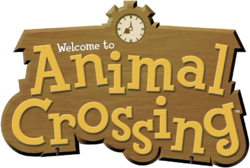| Site Notice |
|---|
|
We have a limited coverage policy. Please check our coverage page to see which articles are allowed. |
Animal Crossing series
| This article is a short summary of Animal Crossing series. Nookipedia features a more in-depth article. |
| Animal Crossing | ||||||||||||||||
| どうぶつの森 | ||||||||||||||||
|
| ||||||||||||||||
| ||||||||||||||||
The Animal Crossing (Japanese: どうぶつの森 Dōbutsu no Mori, literally Animal Forest) is a series of games developed by Nintendo for the Nintendo 64 and Nintendo GameCube in 2001. Released initially as Animal Forest for the Nintendo 64, Animal Crossing has since expanded to include an animated film, manga, a trading card series, and several applications for the Nintendo DSi.
The series focuses on the player living their own virtual life in a village populated with anthropomorphic animals. The series also take place in real time, such as the current time and year.
Contents
History
Animal Crossing began as Animal Forest, a video game initially planned for the Nintendo 64DD, later on moving to the Nintendo 64 due to the delays of the Nintendo 64DD. Takashi Tezuka, the Director for Animal Forest, thought Animal Forest to be a a communication-type game. Katsuya Eguchi, the Producer for Animal Forest, wanted to create an easy game that people of all ages can play. He has also stated that he wanted to have a game that he and his family can play together whether or not he is there to be with the family.
Afterwards, the first game, Animal Forest was released on April 14, 2001 in Japan. Since the Nintendo 64 was near its end and with the game's success, the game was later ported as Animal Forest + onto the Nintendo GameCube and released on December 14, 2001 in Japan. On the first week, Animal Forest + had over 90,000 copies sold. Animal Forest + had new material included onto the game such as the use of GameCube's internal clock, for the game take place in real time. Eventually, an American version of Animal Forest +, named Animal Crossing, was developed; it was released on September 15, 2002 in North America. Animal Crossing had much more material translated and added than Animal Forest +, it had taken over six months to complete it. Impressed by this translation, Nintendo of Japan decides to release this game. Animal Forest e+, was released on June 27, 2003 in Japan, this game sold over 90,000 copies. In addition to the content in the American version, Animal Forest e+ also featured over 80 new villagers.
With the success of the series, a sequel was made onto the Nintendo DS. Animal Crossing: Wild World was released on November 23, 2005 in Japan. The game had sold over 325,460 copies in its first week. Wild World was later released in North America on December 5, 2005. The sixth installment of Animal Crossing, Animal Crossing: City Folk, was released in Japan on November 20, 2008 and November 26, 2008 in North America for the Wii. Recently announced, the seventh installment of the series has been announced for the Nintendo 3DS.
Games
The Animal Crossing series consists of 6 games, most that are remade with new material. What follows is a list of Animal Crossing games by their release date:
| Game | JP release | NA release | EU release | AUS release | KOR release | Platform | |||
|---|---|---|---|---|---|---|---|---|---|
Game
| |||||||||
| Animal Forest | 2001 | N/A | N/A | N/A | N/A | Nintendo 64 | |||
| Animal Forest+ | 2001 | N/A | N/A | N/A | N/A | Nintendo GameCube | |||
| Animal Crossing | N/A | 2002 | 2004 | 2003 | N/A | Nintendo GameCube | |||
| Animal Forest e+ | 2003 | N/A | N/A | N/A | N/A | Nintendo GameCube | |||
| Animal Crossing: Wild World | 2005 | 2005 | 2006 | 2005 | N/A | Nintendo DS | |||
| Animal Crossing: City Folk | 2008 | 2008 | 2008 | 2008 | 2010 | Wii | |||
| Animal Crossing* | TBA | TBA | TBA | TBA | TBA | Nintendo 3DS | |||
Nintendo DSi applications
| |||||||||
| Animal Crossing Clock | 2009 | 2009 | 2009 | 2009 | 2009 | DSiWare | |||
| Animal Crossing Calculator | 2009 | 2009 | 2009 | 2009 | 2009 | DSiWare | |||
References
External links
| ||||
| This article is a stub. You can help NintendoWiki by expanding it. |






